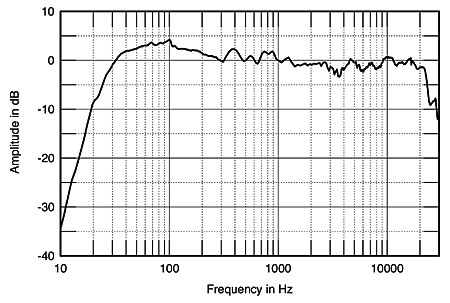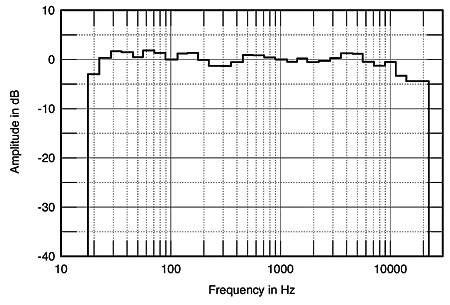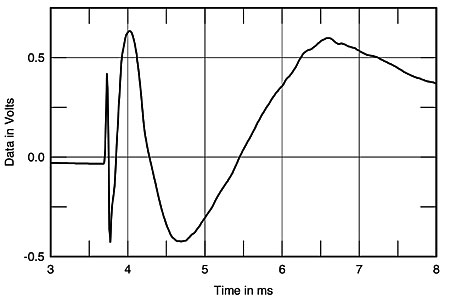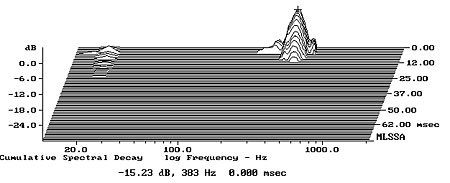| Columns Retired Columns & Blogs |
Sony ES SS-M9 loudspeaker Measurements
Sidebar 3: Measurements
The SS-M9 will go quite loud with only a few amplifier watts; its B-weighted sensitivity weighed in at a calculated 89dB/2.83V/m, the same as specified. However, its impedance (fig.1) remains between 4 ohms and 6 ohms through almost all the bass and midrange, and drops to 3 ohms and below above the audioband, meaning that the matching amplifier should not be fazed by low impedances. The small rise in the magnitude trace just below 200Hz is due to the crossover between the dual woofers and the midrange unit; the slight saddle at 24Hz is a clue to the tuning of the reflex ports. There is a commendable freedom from small wrinkles in the impedance traces which would indicate the presence of enclosure resonances.
Note the shape of the impedance magnitude trace in fig.1 (the solid line). This explains why the sound became too bright with the tubed Cary amplifier: the voltage divider action between the amplifier's high source impedance and the impedance of the speaker will emphasize frequencies in the upper crossover region, between 1kHz and 4kHz.

Fig.1 Sony SS-M9, electrical impedance (solid) and phase (dashed) (2 ohms/vertical div.).
Fig.2 shows the individual responses of the ports, woofers, and midrange/treble drivers on the tweeter axis at a distance of 50". The woofer output is the bandpass curve covering roughly the two octaves between 50Hz and 200Hz, with the port output centered on the woofers' minimum-motion frequency of 27Hz. Both are well-controlled, with an absence of out-of-band nasties. The midrange unit and tweeter outputs seem flat within their passbands, but there is a slight lack of on-axis energy between the two units' ranges at 3.5kHz. The acoustic crossover between the woofers and the midrange appears to be a symmetrical 24dB/octave type. The overall response of the M9, averaged across a 30° horizontal window on the tweeter axis at 50", is shown in fig.3. It is impressively flat, with perhaps a very slight rise in the mid- and upper bass. No wonder I found the Sony speaker to sound so neutral!

Fig.2 Sony SS-M9, acoustic crossover on tweeter axis at 50", corrected for microphone response, with nearfield midrange, woofer, and port responses plotted below 300Hz.

Fig.3 Sony SS-M9, anechoic response on tweeter axis at 50", averaged across 30° horizontal window and corrected for microphone response, with complex sum of nearfield midrange, woofer, and port responses plotted below 300Hz.
Although the handbook goes into some detail on how to ensure that the listener's ears are level with the tweeter, about 38–40" from the floor, the graph of vertical dispersion (not shown) suggested that the SS-M9 is uncritical regarding listening axis. As long as the listener's ears are between 32" and 42" high, he or she will perceive a pretty flat balance. How the Sony's balance changes as the listener moves to the speaker's side is shown in fig.4 (only the changes are shown in this graph, which means that the on-axis response appears as a straight line). Things to note in this graph are that the tweeter's output above 7kHz or so falls quite rapidly to the side. In a typical furnished room, this will lead to the sound lacking some HF "air," as indeed I found.

Fig.4 Sony SS-M9, horizontal response family at 50", normalized to response on tweeter axis, from back to front: differences in response 90°–5° off-axis; reference response; differences in response 5°–90° off-axis.
Note also in fig.4 the slight off-axis "flare" in the speaker's output around 3.6kHz (the cursor position). In a typical room, this will to some extent compensate for the lack of on-axis energy in this region, seen in fig.2. But it might also tend to make the speaker sound a little bright. I suspect that this off-axis behavior did indeed contribute to the speaker's tonal balance. However, fig.5, a spatially averaged curve taken for the Sonys in my room, shows that the in-room balance is almost perfectly flat throughout the midrange and treble. Even including a slight lack of energy in the lower midrange due to residual floor-bounce cancellation, and a slight excess in the mid-treble, it meets astonishing ±1.35dB limits from the 80Hz 1/3-octave band through the 10kHz band. Note that the top octave is rolled off a little, confirming the lack of high-end air to the speaker's treble balance. But also look at the excellent bass extension in-room: –3dB at a low 20Hz.

Fig.5 Sony SS-M9, spatially averaged, 1/3-octave response in JA's room.
In the time domain, the Sony's step response (fig.6) reveals that the drive-units are connected with the same positive acoustic polarity, but that the output of the tweeter arrives before that of the midrange unit, which in turn arrives before that of the woofers. Don't let the sloped-back baffle mislead you: as in any speaker with high-order crossover filters, the design cannot be time-coherent. The associated cumulative spectral-decay or waterfall plot (fig.7) reveals a generally clean decay but with a trace of hash at the top of the midrange unit's passband. This also might tie in with the slight brightness I noted in my auditioning.

Fig.6 Sony SS-M9, step response on tweeter axis at 50" (5ms time window, 30kHz bandwidth).

Fig.7 Sony SS-M9, cumulative spectral-decay plot at 50" (0.15ms risetime).
Despite its use of large panels, the M9's enclosure is impressively rigid. Fig.8 shows a waterfall plot calculated from the output of a simple plastic-tape accelerometer fastened to one of the sloped side panels, about 12" from the top. The only resonant mode apparent is relatively high in frequency, at 380Hz, and very low in level, both facts suggesting that the large cabinet is well-braced and intelligently designed. (The more rigid a cabinet, the higher in frequency its panel resonant modes will be; the higher in frequency the resonances, the smaller the chance they will be excited with music and the shorter the time they will ring if they are excited.)—John Atkinson

Fig.8 Sony SS-M9, cumulative spectral-decay plot of accelerometer output fastened to side of enclosure 12" from top (MLS driving voltage to speaker, 7.55V; measurement bandwidth, 2kHz).
- Log in or register to post comments




































